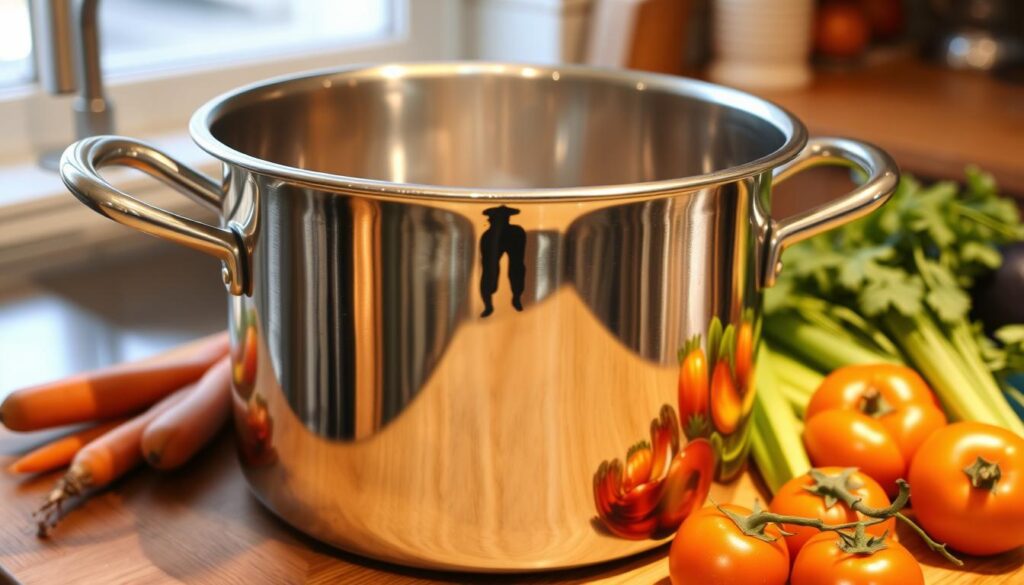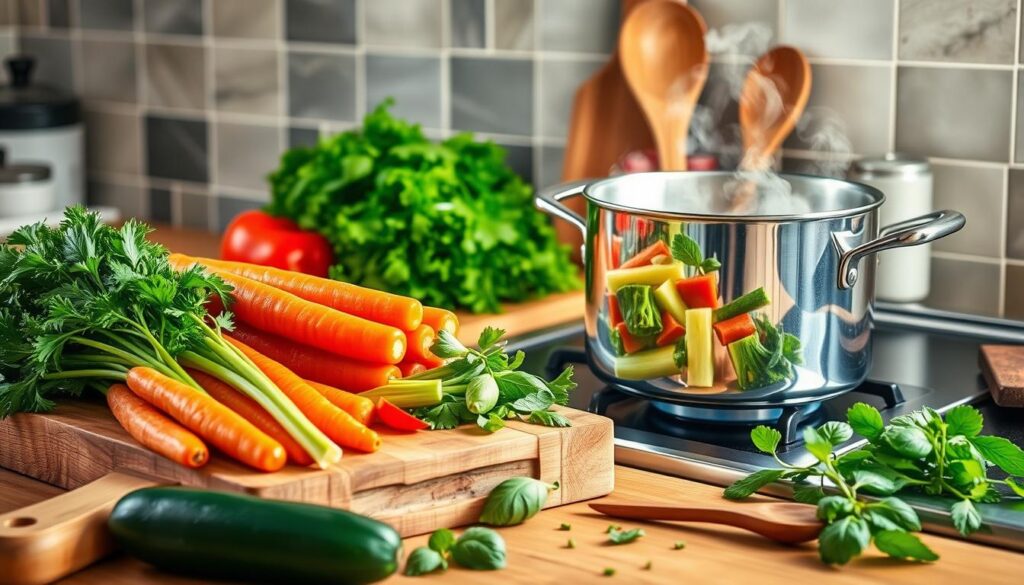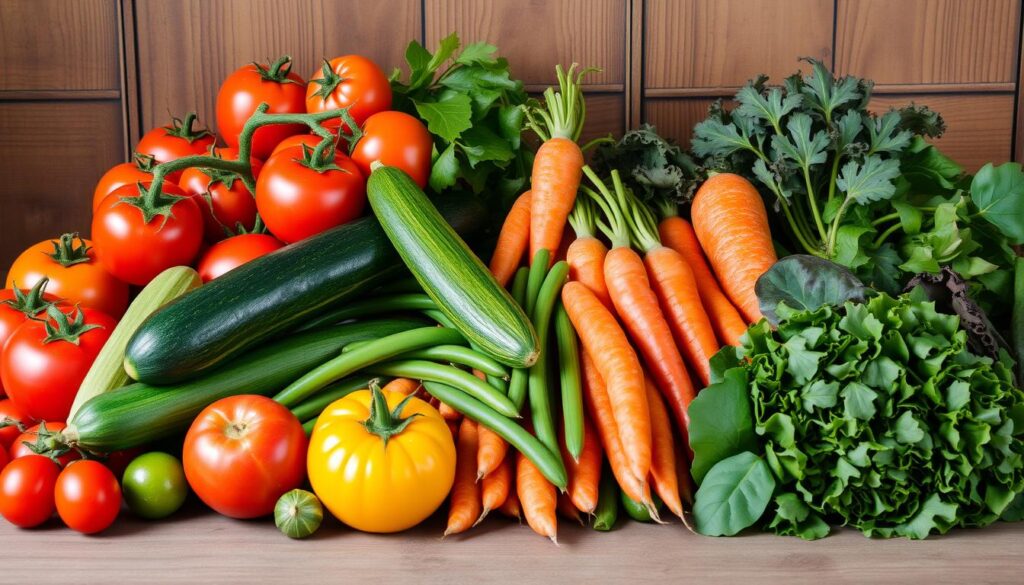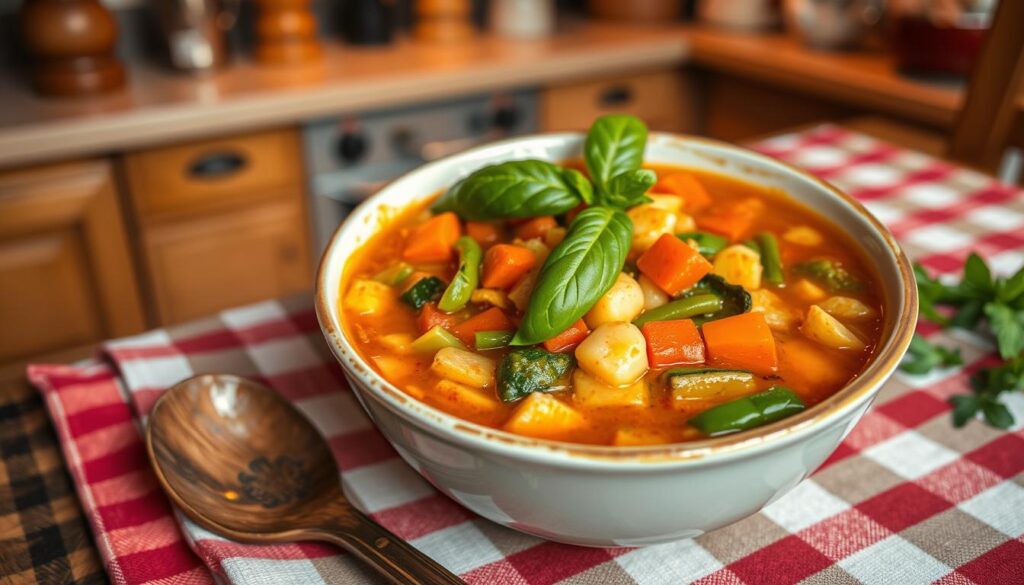Discover the comforting allure of a steaming bowl of authentic Italian Minestrone soup. This hearty, vegetable-packed dish has been a beloved staple in Italian cuisine for centuries. It offers a nutritious and satisfying meal for all seasons.
In this recipe, we’ll guide you through the simple steps to creating a classic Minestrone soup right in your own kitchen. You’ll get to enjoy the rich flavors and wholesome goodness of this iconic Italian dish.
Key Takeaways
- Minestrone soup is a classic Italian dish that is both nutritious and satisfying.
- This recipe provides a simple and easy-to-follow guide to making authentic Minestrone soup at home.
- Minestrone soup is a versatile dish that can be enjoyed year-round as a comforting and nourishing meal.
- The key to a delicious Minestrone soup lies in the selection of fresh, seasonal vegetables and the perfect balance of flavors.
- Minestrone soup is a great option for those looking for a healthy, hearty, and flavorful soup to incorporate into their meal planning.
The Rich History and Origins of Traditional Italian Minestrone
The Italian food history is rich and diverse. It has many regional cuisines that have changed over centuries. One dish that has lasted is the beloved traditional soup called minestrone. This hearty vegetable-based broth comes from the culinary traditions of regional Italian cuisine.
Evolution of Minestrone Through Italian Regions
Minestrone’s roots go back to ancient Rome. It was a simple, nourishing soup made from seasonal vegetables. As it spread across Italy, different regions made their own versions. Each one showed off local ingredients and cooking styles.
- In the north, minestrone often includes rice or pasta, while in the south, it may feature beans or legumes as the primary starch.
- Tuscan minestrone is known for its thick, creamy texture, while Ligurian versions often highlight fresh pesto.
- Sicilian minestrone might include eggplant or zucchini, while Venetian renditions may feature seafood.
Cultural Significance in Italian Cuisine
Minestrone soup is a beloved staple in Italian cuisine. It crosses class lines and is a comforting, affordable meal. It shows Italy’s love for seasonal, local ingredients and turning simple foods into something special.
“Minestrone is more than just a soup in Italy – it’s a cultural institution, a way of life, and a testament to the country’s rich food heritage.”
Today, the traditional soup is still loved, with families passing down their minestrone recipes. As it evolves, it reminds us of the lasting impact of Italian food history and the importance of regional Italian cuisine.
Essential Ingredients for Authentic Minestrone Soup Recipe
Minestrone soup is a hearty, vegetable-packed delight that warms the soul. It’s made with a special mix of Minestrone ingredients that give it its unique flavor and texture. Let’s look at the key parts that make a real minestrone soup special.
The base of minestrone is a tasty soup base. It’s made from tomatoes, broth, and veggies like onions, carrots, and celery. These ingredients create a savory background that lets the other Italian vegetables stand out.
- Seasonal vegetables: Minestrone lets you use a variety of fresh, seasonal produce. You can add zucchini, green beans, peas, and leafy greens like spinach or kale.
- Beans: Kidney, cannellini, or garbanzo beans make the soup hearty and add protein, giving it a classic rustic feel.
- Pasta or grains: Small pasta shapes like ditalini, elbow macaroni, or short grain rice are often added. They add a satisfying starch to the soup.
Minestrone’s beauty is in showing off the best Minestrone ingredients the season offers. By picking and mixing these key elements, you can make a real, nourishing minestrone soup. It celebrates Italy’s rich culinary traditions.

“Minestrone is not just a soup, it’s a culinary masterpiece that captures the essence of Italian cuisine.”
Kitchen Tools and Equipment You'll Need
Making an authentic Italian Minestrone soup needs the right tools and equipment. From the essential soup pot to helpful gadgets, the right cooking essentials are key. They help achieve the perfect texture and flavor. Let’s look at the must-have cookware and optional tools that will make your Minestrone soup better.
Must-Have Cookware for Perfect Results
The heart of a great Minestrone soup is the soup pot. Choose a large, heavy-bottomed pot for all your ingredients. Stainless steel or enameled cast iron is best for even heat and to prevent scorching. Also, a sharp chef’s knife and a sturdy cutting board are crucial for chopping veggies efficiently.
Optional Kitchen Gadgets to Make Preparation Easier
While not essential, some kitchen utensils and cooking equipment can make Minestrone soup easier to make. A high-quality vegetable peeler helps quickly remove skins. A mandoline slicer ensures uniform cuts, and a food processor finely chops ingredients. These tools save time and ensure consistent results.

Remember, the secret to a great Minestrone soup is the love and care you put into it. With the right tools, you’ll be on your way to making a delicious, authentic Italian classic.
Step-by-Step Preparation Guide
Making a real Minestrone soup is a fun journey. It mixes fresh ingredients with old techniques. Follow this guide to make this Italian favorite at home.
- First, get all your cooking ingredients ready. Chop onions, carrots, celery, and zucchini into small pieces.
- In a big pot or Dutch oven, cook the onions, carrots, and celery in olive oil. Do this over medium heat until they’re soft and smell good, about 5-7 minutes.
- Add the rest of the vegetables, like zucchini and potato, and any others you want. Keep cooking for 3-5 minutes more.
- Then, pour in vegetable or chicken broth. Bring the soup preparation to a gentle simmer. Let the veggies cook for 10-15 minutes, until they’re tender.
- Next, add the cooked pasta and beans. Season the Minestrone recipe with salt, pepper, and herbs or spices you like.
- Simmer the soup for another 10-15 minutes. This lets the flavors mix and the pasta and beans warm up.
- Check the soup’s taste and adjust the seasoning if needed. Serve hot, topped with Parmesan cheese or parsley if you like.
With this guide, you can make the rich, comforting Minestrone soup at home. Enjoy your homemade dish!

Mastering the Perfect Vegetable Combinations
Making a delicious minestrone soup needs the right mix of fresh, seasonal veggies. Finding the perfect vegetable combinations is key. It makes the soup balanced and flavorful, just like traditional Italian cooking.
Seasonal Vegetable Pairings
Choose veggies based on the season and what’s locally available. For a spring minestrone, use spinach, kale, or fresh peas. Add tender asparagus and zucchini too. When summer comes, use ripe tomatoes, bell peppers, and eggplant. In the fall and winter, carrots, potatoes, and parsnips add warmth and depth.
Texture and Flavor Balance Tips
- Try different textures, from big chunks to small pieces, for a fun mouthfeel.
- Balance sweet veggies like onions and carrots with herbs and spices for a savory taste.
- Use contrasting flavors, like mushrooms or tomatoes, to make the soup more interesting.
| Vegetable | Contribution to Minestrone |
|---|---|
| Onions | Provide a savory base and sweetness to the broth. |
| Carrots | Add a natural sweetness and vibrant color to the soup. |
| Celery | Impart a subtle crunch and a depth of flavor to the broth. |
| Tomatoes | Contribute acidity and richness to the overall taste profile. |
| Leafy Greens | Lend a fresh, nutritious element to the soup. |
By picking and balancing your veggies well, you make a soup that looks great and tastes amazing.

Best Pasta and Bean Options for Your Minestrone
Choosing the right pasta and beans is key to a great minestrone soup. These elements bring the authentic Italian taste and texture to your dish. Let’s look at the top picks to make your homemade minestrone stand out.
Pasta Perfection
For a classic minestrone, go for small pasta like ditalini, tubetti, or pastina. These shapes fit well in the broth and offer a nice chew. You can also try small macaroni or elbow pasta for a bit more heft. Or, pick whole-wheat or gluten-free pasta for different diets.
Beantastic Additions
Minestrone needs soup beans for flavor. Favorites include cannellini beans, kidney beans, or garbanzo beans (chickpeas). They add creaminess and nutrition. Mixing different beans makes the soup more filling.
| Pasta Type | Bean Variety | Cooking Time | Texture Contribution |
|---|---|---|---|
| Ditalini | Cannellini Beans | 8-10 minutes | Firm and Chewy |
| Tubetti | Kidney Beans | 12-15 minutes | Creamy and Hearty |
| Whole Wheat Macaroni | Garbanzo Beans | 10-12 minutes | Nutty and Satisfying |
It’s important to cook the pasta and beans together. This way, they’re both tender and blend well with the broth.
Tips for Achieving the Perfect Broth Consistency
Making the perfect soup broth is key to a great Minestrone. Italian chefs use a few secrets to get it just right. Let’s dive into the art of making broth.
Traditional Thickening Methods
One way to thicken soup broth is with starch. Italian cooks often use:
- Bread or breadcrumbs
- Potatoes or squash
- Pureed beans or legumes
These starchy ingredients make the broth creamy. Another method is to simmer the soup longer. This lets the vegetables’ starches thicken the broth.
Seasoning Secrets from Italian Chefs
The Italian seasoning mix is crucial for flavor balance. Italian chefs use herbs like:
- Rosemary
- Oregano
- Basil
- Thyme
Adjusting these herbs and spices enhances the broth’s taste. A bit of acid, like lemon or vinegar, brightens the flavors.
By learning these cooking techniques, you can improve your Minestrone. Try different thickening and seasoning methods to find your favorite.
Storage and Reheating Guidelines
Keeping your homemade leftover soup fresh is key. Whether it’s extra Italian Minestrone soup or a batch you want to revive, here are some tips. They’ll help your soup stay tasty and fresh.
Refrigerating Leftover Soup
For up to 4 days, you can store leftover Minestrone soup in the fridge. Use airtight containers or resealable bags, leaving some space for expansion. Cool the soup down before refrigerating to stop bacteria from growing.
Freezing Minestrone Soup
- Minestrone soup freezes well, perfect for long-term leftover soup storage.
- Cool the soup completely, then put it in freezer-safe containers or bags. Leave about an inch of space for expansion.
- Properly frozen Minestrone can last up to 3 months in the freezer.
Reheating Tips
- Refrigerated soup: Warm it gently on the stovetop over medium heat, stirring often, until it’s warm.
- Frozen soup: Thaw it in the fridge overnight before reheating on the stovetop.
- For quick reheating tips, thaw frozen soup in the microwave or on the stovetop, stirring often.
By following these easy storage and reheating tips, you can enjoy your homemade Minestrone soup for days or even weeks.
Serving Suggestions and Complementary Side Dishes
Minestrone soup is a delightful dish that can be enjoyed as the centerpiece of a hearty Italian meal. To create a well-rounded dining experience, consider incorporating traditional Italian pairings and modern serving ideas. These will elevate your homemade minestrone to new heights.
Traditional Italian Pairings
No Italian meal is complete without the classic accompaniment of crusty bread. Serve your minestrone with a selection of freshly baked rolls, crusty Italian breads, or even crostini. Guests can dip and soak up the flavorful broth.
Complement the soup’s rustic charm by offering a platter of Italian cheeses. Parmesan, Pecorino Romano, or Mozzarella are all great choices for an authentic touch.
Modern Serving Ideas
To add a modern twist to your minestrone presentation, consider serving the soup in individual bowls or mugs. Garnish with a drizzle of high-quality olive oil, a sprinkle of freshly grated Parmesan, and a sprig of fragrant basil or parsley.
For a heartier meal, pair the soup with a crisp green salad, roasted vegetables, or grilled Italian sausages. This will give you a satisfying and well-rounded dining experience.
FAQ
What are the key ingredients in a traditional Italian Minestrone soup?
A traditional Minestrone soup includes onions, carrots, celery, zucchini, beans, pasta, and a tasty broth. The vegetables used can change based on the region. But, it always has a mix of fresh, hearty produce.
What is the history and cultural significance of Minestrone soup in Italy?
Minestrone soup comes from ancient Rome. Over time, it has changed with regional tastes and ingredients. It’s a beloved dish in Italy, bringing families and communities together with its comforting taste.
What kitchen tools and equipment are needed to make the perfect Minestrone soup?
You’ll need a big soup pot or Dutch oven, a sharp knife, a cutting board, a ladle, and basic utensils. Tools like a food processor or mandoline can also help with prep.
How do I achieve the right broth consistency for my Minestrone soup?
For the right broth, mash some cooked beans or veggies, or simmer longer to thicken. Seasoning with Italian herbs and spices can also improve the flavor and texture.
What are some tips for storing and reheating leftover Minestrone soup?
Store Minestrone in the fridge for 4-5 days or freeze for months. Reheat gently on the stovetop to avoid overcooking. Add broth or water if it’s too thick.
Share this post: on Twitter on Facebook

